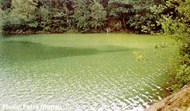Algae are primitive plants which first developed in the seas 3.5 billion years ago. Some algae are microscopic (planktonic algae), others are thin and stringy or hair-like (filamentous algae), while still others are large and resemble higher plants but without true roots (muskgrass/chara). Today, algae produce over half of the oxygen we breathe while providing the base for aquatic food chains. Algae species readily absorb excess pond nutrients like ammonia, nitrate, and phosphate.
Nuisance algae creates many problems including lower levels of dissolved oxygen, reduced clarity, aesthetic issues, health concerns and more. Excessive algae growth may also cause the death of submerged plants. Identify the algae problem; learn more then choose the recommended solution. Not sure what species of algae you are dealing with? Our biologists are always here to help! Call us at 1-800-442-6648 or contact us by email info@aquaticbiologists.com.
Common Problem Algae:
Filamentous - Matted Algae
Surface mats are bubble filled and usually appear green but can become yellow to brownish. Prior to maturing beneath the surface, algae may appear like stringy cotton candy strands attached to rocks, dock legs or weeds.
Planktonic - Pea Soup Algae
The type that changes the water color. Usually green paint-like scum appearance (pea soup). May be brown or even red. Blooms are composed of diatoms, blue-green algae, and green algae and other species.

Macroalgae - Chara, Nitella, Starry Stonewort, etc.
An advanced form of algae that looks like a vascular plant. Generally, Chara and other branched algae species grow in dense mats along the bottom but can reach the surface in shallow waters. Chara feels coarse and has a musky odor; it will rapidly decay when removed from water.

